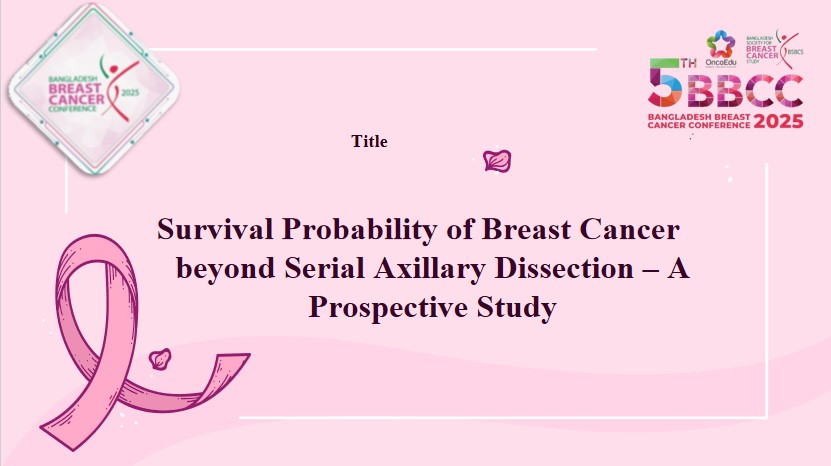Survival probabilities of breast cancer patients beyond serial axillary node dissection – A prospective study
Authors: A. K. Mostaque, A. M. M. Shariful Alam, M. Kamal
Institution: Gonoshayasha Somaj Vittik Medical College
Introduction
Introduction of radiotherapy in breast cancer (BC) multimodality treatment has obscured therapeutic value of ipsilateral axillary lymph node dissection (ALND). Now occasional ALND is indicated as a part of BC therapy and axillary sampling in the form of sentinel lymph node (LN) biopsy (SLNB) counts only positive nodes is the routine procedure for pathological node (pN) staging to forecast prognosis with idea that pN staging could efficiently anticipate prognosis of BC. The objectives were to (1) determine pathological node (pN) and lymph node ratio (LNR) subgroups of patients, (2) observe distribution of recurrences and deaths of patients according to pN stages and LNR subgroups, and (3) estimate survival functions of disease free (DFS) and overall survival (OS) after death of all cases of any one subgroups observed during follow-up.
Methods
This prospective cohort study was conducted on 51 consecutively treated BC patients treated at Ahsania Mission Cancer and General Hospital, Uttara, Dhaka . All included patients underwent modified radical mastectomy in majority of cases, oncoplastic surgery, pedicelled latissimus dorsi myocutaneous flap reconstruction, and skin sparing key whole mastectomy along with serial ALND. Data collected on number of total and positive axillary LNs, pN staging, LNR subgroups, and DFS and OS of treated BC patients at defined follow-up date (December, 2022) when all cases belonged to anyone subgroup died. Follow-up should continue till a total of 75% cases are died and censored.
Results
Patient distribution between pN and LNR subgroups indicated highly significant difference in between pN3 and high-risk LNR (p = 0.000001). The median duration of DFS and OS were 49.23 and 52.63 months respectively. The number of recurrences, deaths, and censored were 17 (33.3%), 21 (41.2%), and 5 (9.8%) respectively. Survival functions of DFS indicated curves of pN0 subgroup had best and of pN1, pN2, and pN3 had similar but worst survival time. Pair wise comparison indicated significant difference between pN0 and pN2 (p = 0.048) only. The DFS of LNR subgroups indicated highly significant difference between low- and high-risk (p = 0.000003), and between intermediate- and high-risk (p = 0.000115) LNR. The curves of low- and intermediate-risk LNR of DFS were similar (p = 0.958) with best and of high-risk the worst survival time. The estimated mean survival of OS of pN sages indicated no significant difference. The pN0 and pN1 curves were similar with best and, pN2 and pN3 curves were similar with worst survival. Survival functions of OS of LNR subgroups indicated highly significant difference between low- and high-risk (p = 0.000049), and between intermediate- and high-risk (p = 0.000014) LNR. No significant difference was observed between low- and intermediate- risk LNR (p = 0.641) Survival functions estimator plots of OS indicated curves of low- and intermediate-risk were similar with best and of high-risk LNR worst survival.
Conclusion
Lymph node ratio unveil greater number of high-risk cases, powerfully forecast prognosis with high precision, and should be introduced in Tumor Node Metastasis classification providing axillary lymph node dissection should be reintroduced as routine procedure. Proposal is affix lymph node ratio to pathological node stages of Tumor Node Metastasis staging of breast cancer & should show number of +ve lymph nodes/total dissected axillary lymph nodes as superscript (e.g. pN 17/26). Counting only positive axillary lymph node is unreal to forecast prognosis. This research work discovered that introduction of ipsilateral axillary lymph node dissection simplify oncoplastic breast surgery by slashing the heavy workload of symmetrization of opposite normal breast and of plastic surgeons, minimize postoperative complications and scar tissue formation, and ensures the best possible long term aesthetic outcome of the breasts.
